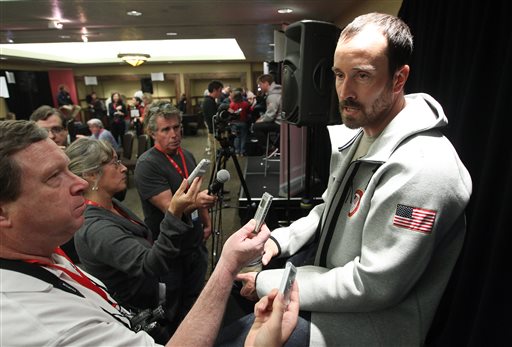PARK CITY, Utah (AP) — Seth Wescott looks to his father, who will be rowing in the prestigious Head of Charles Regatta later this month at age 70, and figures he should have no problem racing his snowboard down a mountain when he reaches 41.
The 37-year-old Wescott is overcoming a knee injury in hopes of being healthy for the Sochi Olympics, where he would have a chance to win snowboardcross for the third straight time. But before he even begins that quest, he’s committing to staying in his sport through at least 2018, a year after he hits the big ‘4-0.’
“I believe in myself as an athlete and in my genetics,” Wescott said Wednesday at the U.S. Olympic Committee’s media summit. “I know I have the ability to have longevity in this sport. As long as I’m progressing, and I have been, then there’s no way I’m going to walk away.”
Wescott is his sport’s walking definition of a wily veteran. He sacrifices quantity for quality, has not been a race-every-stop-on-the-circuit guy for a long time, instead carefully picking and choosing his spots to shine.
He saves his best for the Olympics.
His victory at the Vancouver Games was a tactical masterpiece. Given the worst starting position in the final because of his middle-of-the-pack qualifying time, Wescott got a rare piece of pre-race advice from his coach, Jeff Archibald: Hang back, let the other guys get out in front, then reel them in.
He executed it perfectly, overcoming Canadian Mike Robertson over the last two turns and crossing the line for his second straight gold medal.
“It was amazing to have someone who has that belief in you say, ‘I’m most worried you get to that part of the course, and if you do, I believe you have the skills to get to the finish line first,”‘ Wescott said.
Though snowboardcross, with its four-to-six-wide racing through icy bumps and turns, is about as rough a sport as they come, there is a tactical part to this sort of racing that can work to an older rider’s advantage.
Five of the top 12 riders in the current world standings are 30 or over.
“You have to have a bag of tricks, if you will,” Wescott said. “You have a skill set. You have turning, gliding, ability in starts, quick-twitch features. That whole skill set comes into play. In that way, I know I’m still one of the most prepared men in that discipline.”
Wescott’s biggest roadblock on the way to Sochi will be how quickly his left knee recovers. In April, he had his anterior cruciate ligament completely restructured. That injury came about a year after he was sidelined with a torn pectoral muscle.
Earlier this year, he moved from his home in Maine to Park City, Utah, where he could avail himself of the full-time rehab services offered by the U.S. Ski and Snowboard team.
Last month, Wescott was in New Zealand, making turns on snow a full two months earlier than doctors anticipated.
But Wescott knows, “the knee is going to heal at the knee’s pace.”
Though he’s optimistic, he knows if it’s not 100 percent by the time qualifying events begin in December, he could miss his chance at history next February. Wescott, Shaun White and Shani Davis could all have chances to become the first American man to win the same event at the Winter Olympics three times in a row. White’s and Davis’ finals are before Wescott’s.
Regardless of how that plays out, Wescott plans on being there in South Korea come 2018.
“There’s a little uncertainty of where I’m going to be by the time I have to qualify and I wouldn’t want that to be the end of the line,” Wescott said. “I want to go out on my own terms and I want to go out feeling I’m performing at my best. And I still think I have many years of being able to do that.”
——
Follow Eddie Pells at www.twitter.com/epells
Send questions/comments to the editors.



Success. Please wait for the page to reload. If the page does not reload within 5 seconds, please refresh the page.
Enter your email and password to access comments.
Hi, to comment on stories you must . This profile is in addition to your subscription and website login.
Already have a commenting profile? .
Invalid username/password.
Please check your email to confirm and complete your registration.
Only subscribers are eligible to post comments. Please subscribe or login first for digital access. Here’s why.
Use the form below to reset your password. When you've submitted your account email, we will send an email with a reset code.